Teguise (municipality)
Teguise (pronounced [teˈɣise]) is a municipality in the central part of the island of Lanzarote in the Las Palmas province in the Canary Islands. The population is 22,342 (as of 1 January 2019),[3] and the area is 263.98 km².[1] It is located north of Arrecife and south of Haría. The seat of the municipality is the town of Teguise. The municipality also comprises a number of neighbouring islands including Graciosa (with 733 inhabitants in 2019), Alegranza, Roque del Este, Roque del Oeste and Montaña Clara.
Teguise | |
|---|---|
 Flag 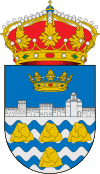 Coat of arms | |
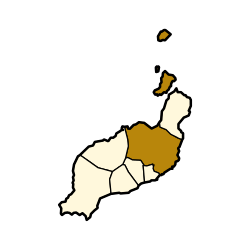 Municipal location in Lanzarote | |
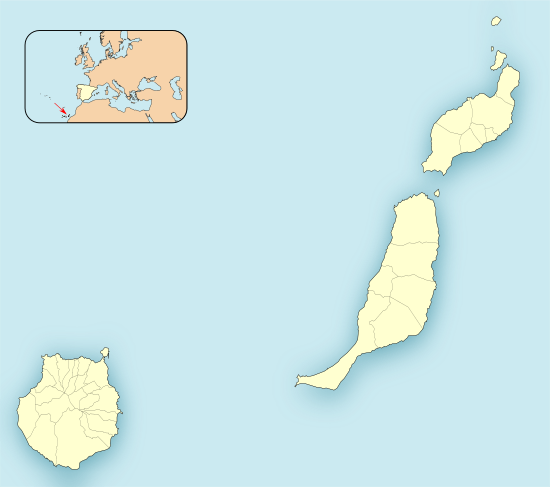 Teguise Location in the province of Las Palmas 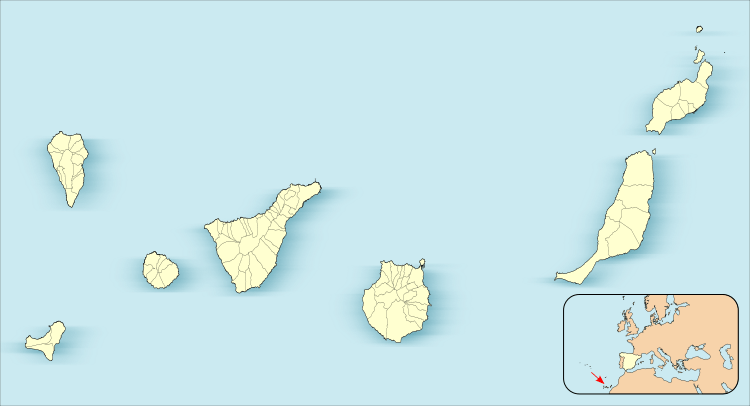 Teguise Teguise (Canary Islands)  Teguise Teguise (Spain, Canary Islands) | |
| Coordinates: 29°3′N 13°34′W | |
| Country | |
| Autonomous community | |
| Province | Las Palmas |
| Government | |
| • Mayor | Oswaldo Betancort García (CC) |
| Area | |
| • Total | 263.98 km2 (101.92 sq mi) |
| Elevation | 360 m (1,180 ft) |
| Population (2018)[2] | |
| • Total | 22,122 |
| • Density | 84/km2 (220/sq mi) |
| Time zone | UTC±0 (WET) |
| • Summer (DST) | UTC+1 (WEST) |
| Website | Official website |
The artist and architect César Manrique was born in the area. The insect of the island is the cochineal from which carmine, a dye, is extracted.
Historical population
| Year | Pop. | ±% |
|---|---|---|
| 2000 | 12,184 | — |
| 2001 | 12,905 | +5.9% |
| 2002 | 13,714 | +6.3% |
| 2003 | 14,214 | +3.6% |
| 2004 | 14,477 | +1.9% |
| 2005 | 15,824 | +9.3% |
| 2006 | 16,616 | +5.0% |
| 2007 | 17,688 | +6.5% |
| 2008 | 18,798 | +6.3% |
| 2009 | 19,418 | +3.3% |
| 2010 | 20,105 | +3.5% |
| 2011 | 20,788 | +3.4% |
| 2012 | 21,096 | +1.5% |
| 2013 | 21,152 | +0.3% |
| 2014 | 21,101 | −0.2% |
| 2015 | 21,454 | +1.7% |
| 2016 | 21,724 | +1.3% |
| 2017 | 21,896 | +0.8% |
| 2018 | 22,122 | +1.0% |
| Source: INE[3] | ||
Settlements
- Las Cabreras
- Caleta de Sebo [lower-alpha 1]
- Casas de Pedro Barba [lower-alpha 1]
- Caleta de Famara
- Las Caletas
- Costa Teguise
- Guatiza
- Las Laderas
- El Mojón
- Mozaga
- Muñique
- Nazaret
- Sóo
- Tahiche
- Tao
- Teguise
- Teseguite
- Tiagua
- Los Valles
- Los Ancones
- Caleta de Caballo
- Los Cocoteros
- Charco del Palo
- Tomarén
- on the island of La Graciosa
Sites of interest
- Jardín de Cactus, in Guatiza
- Wind sculpture
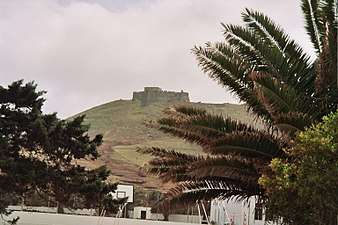 Santa Bárbara Castle
Santa Bárbara Castle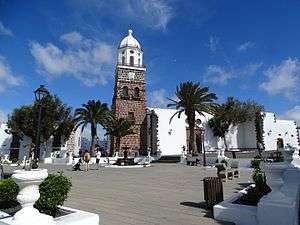 Teguise Church, bell tower
Teguise Church, bell tower Typical architecture in Teguise
Typical architecture in Teguise- Isla de la Graciosa (la Graciosa Island)
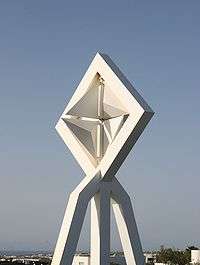 Wind sculpture by César Manrique, Taro de Tahíche
Wind sculpture by César Manrique, Taro de Tahíche
gollark: ANOMALOUS ones, perhaps.
gollark: Such as, say, 100KB of random letters, since nobody cares enough to tell other people that.
gollark: Antimemes are basically just ideas which don't spread very well.
gollark: > antimemes aren't realAntimemes are real, anomalous antimemes less so.
gollark: You may be considering escape. This is unwise.
References
- Instituto Canario de Estadística, area
- Municipal Register of Spain 2018. National Statistics Institute.
- "Palmas, Las: Población por municipios y sexo" [Palmas, Las: Population by municipality and gender]. Instituto Nacional de Estadística (in Spanish). Retrieved 2019-03-23.
This article is issued from Wikipedia. The text is licensed under Creative Commons - Attribution - Sharealike. Additional terms may apply for the media files.